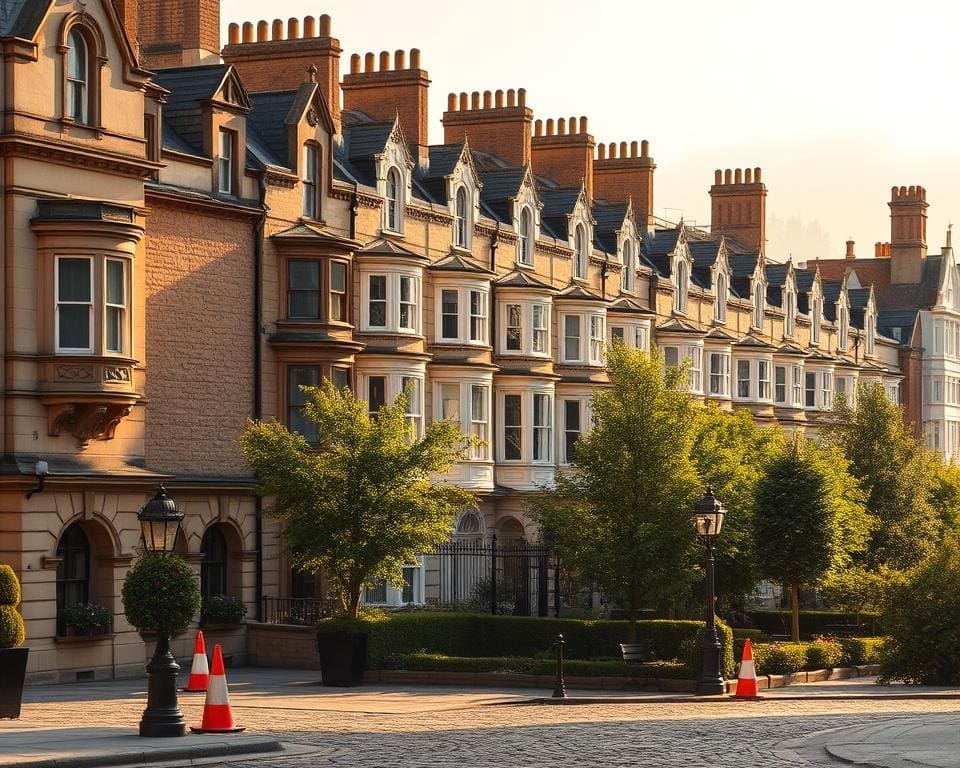Renovating a listed building in England presents a unique set of challenges, rooted in the need to preserve architectural and historical integrity. Property owners often grapple with stringent regulations and specific guidelines designed to protect these significant structures. Understanding what makes a listed building in England hard to renovate is essential for those looking to undertake property restoration, as it not only involves adhering to legal frameworks but also requires specialised materials that align with the building’s original character.
The balance between modernisation and the preservation of historical value creates additional renovation challenges. Each listed building has its one-of-a-kind features that demand careful consideration and expertise to ensure any renovations respect and enhance their legacy.
Understanding Listed Buildings in England
Listed buildings in England represent a significant part of the nation’s architectural heritage. These structures are classified into three distinct grades: Grade I, Grade II*, and Grade II. This system ensures that buildings of exceptional architectural or historical importance receive appropriate protection. Grade I buildings are of exceptional interest, while Grade II* structures are considered particularly important, and Grade II buildings hold national significance.
The listing process plays a crucial role in maintaining the integrity of these properties. Any alterations made to listed buildings must respect their historical value, prompting property owners to engage deeply with the architectural heritage of their locales. Preserving these important structures not only safeguards their physical form but also fosters a connection to the community’s identity, reflecting the unique character and stories embedded within local history.

The Importance of Architectural Heritage
Architectural heritage represents a vital component of our shared history, serving as a testament to the craftsmanship and creativity that define various eras. These structures encapsulate the stories and identities of communities, providing a tangible connection to past generations. The preservation of architectural heritage is not merely about maintaining physical buildings; it is about safeguarding the essence and cultural identity they embody.
Property restoration plays a crucial role in this endeavour. By restoring historic properties, communities can revive their architectural gems, ensuring that the skills and designs of previous artisans are not forgotten. These efforts do not only enhance the aesthetic appeal of the environment but also help in maintaining the historical value that such structures hold.
The significance of architectural heritage extends beyond mere nostalgia. It fosters a sense of pride among residents and contributes to a vibrant community atmosphere. Investing in restoration projects gives life to historical spaces, promoting cultural tourism and generating economic benefits while ensuring that future generations can appreciate the craftsmanship and stories embedded in their surroundings.
What Makes a Listed Building in England Hard to Renovate?
Renovating a listed building involves numerous complexities defined by a strict legal framework designed to preserve the architectural heritage of these structures. Property owners face unique renovation challenges that often require navigating a myriad of regulations and guidelines tailored to protect the historical significance of these buildings.
Legal Framework Surrounding Listed Buildings
The legal framework governing listed buildings is characterised by comprehensive regulations that ensure any alterations are meticulously controlled. Owners must seek permission from local authorities, which often entails submitting detailed proposals that demonstrate a commitment to preserving the building’s distinct character. Engaging with conservation officers early in the process can help clarify the necessary steps and prevent potential setbacks.
Types of Listed Buildings and Their Unique Challenges
Recognising the types of listed buildings is crucial in understanding the associated renovation challenges. Grade I buildings, often deemed of exceptional interest, demand rigorous adherence to original materials and restoration techniques. Grade II buildings, while still of historical importance, may offer some flexibility, allowing for modern conveniences. Each category presents its distinct hurdles that owners must tackle to balance the preservation of history with the practical needs of contemporary living.
Renovation Challenges Faced by Property Owners
Renovating a listed building presents distinctive renovation challenges that can often deter property owners. As these structures are steeped in historical significance, the need to preserve their character while ensuring safety is paramount.
Structural Integrity Concerns
One of the primary issues property owners encounter involves structural integrity. Older buildings may suffer from wear and tear that compromises their foundational stability. This necessitates a careful assessment of beams, walls, and roofs to ensure that any proposed renovations do not jeopardise the building’s soundness. Addressing these concerns often requires a detailed investigation, including the analysis of original materials and their current condition. Restoration efforts must balance the need for strong, safe structures while maintaining the architectural features that define the building.
Limited Access to Modern Materials
Another significant hurdle stems from limited access to modern materials suitable for these historic properties. Often, contemporary products fail to align with the aesthetic or functional requirements of listed buildings. Finding alternatives that respect the integrity of the original design can be a daunting task. This challenge compels property owners to seek out period-appropriate materials, which may involve extensive research and the engagement of skilled craftsmen familiar with conservation techniques. Navigating these complexities is vital for successful renovations that honour the past while accommodating modern lifestyles.
Historical Preservation Laws and Their Impact
Historical preservation laws in the United Kingdom play a pivotal role in maintaining the integrity of listed buildings. Under the Planning (Listed Buildings and Conservation Areas) Act 1990, these laws are designed to protect structures deemed of special architectural or historical interest. Property owners must navigate these regulations to ensure their renovation projects comply.
These laws mandate that any alterations to a listed building require official approval. This ensures that the distinctive features and historical significance of the structure remain intact. Failing to adhere to historical preservation laws can result in significant penalties, including the requirement to restore the building to its original state.
Understanding these legal frameworks is essential for anyone contemplating renovation. Awareness of the restrictions in place guides property owners through the complexities of maintaining a listed building without compromising its heritage. In essence, embracing these laws can lead to a more respectful and sustainable approach to renovation.
Conservation Restrictions and Guidelines
In the realm of architectural heritage, conservation restrictions and guidelines play a pivotal role in safeguarding the essence of historic buildings. These regulations are crafted to protect not only the physical structure but also its character and the aesthetic of the surrounding environment. For property owners, awareness of these conservation restrictions is essential.
Understanding the guidelines provides clarity on the types of materials permitted, methods of restoration, and overall design approaches acceptable for renovations. By adhering to these standards, owners can enhance the likelihood of a successful restoration while honouring the historical significance of their properties.
A few key points regarding conservation restrictions include:
- Restrictions on altering the exterior appearance of the building.
- Guidelines on the use of traditional materials and techniques that align with the original design.
- Requirements for obtaining permission for any alterations to the property.
Ultimately, these conservation restrictions and guidelines not only establish a framework for preservation but also serve to educate property owners. As they navigate the complexities of renovation, having a comprehensive understanding of these guidelines promotes a respectful approach to architectural heritage, ensuring that the historical narrative continues to thrive for future generations.
Finding the Right Professionals for Restoration
Restoration of a listed building demands the expertise of skilled professionals who understand the intricate balance between preserving historical integrity and implementing modern techniques. Engaging architects, conservation specialists, and builders knowledgeable in property restoration is crucial for maintaining the unique character of these structures. The complexities often associated with listed buildings necessitate a bespoke approach to renovation, making a deep understanding of architectural heritage essential.
Property owners embarking on this journey often find it beneficial to connect with professional organisations dedicated to this field. Joining groups like the Royal Institute of British Architects (RIBA) or the Society for the Protection of Ancient Buildings (SPAB) provides access to valuable resources. These organisations maintain directories of qualified professionals experienced in the nuances of restoration work, ensuring that owners can find experts suited to their specific needs.
When selecting professionals, it’s vital to consider their track record with listed buildings. This expertise often leads to innovative solutions that respect the original craftsmanship while accommodating contemporary requirements. Investing in the right team not only enhances the quality of the restoration but also helps to honour the historical significance embedded within each listed building.
Balancing Modern Needs with Historical Value
Achieving a balance between modern needs and historical value is essential for successful property restoration. Property owners are often faced with the challenge of integrating contemporary comforts into these cherished buildings without sacrificing their unique character and significance. The art of renovation is not merely about updating facilities; it’s a commitment to preserving the essence of history while enhancing the functionality of these exceptional structures.
Innovative solutions have emerged to address these challenges, allowing for upgrades that respect the architectural integrity of listed buildings. Techniques such as invisible insulation and discreet electrical systems can seamlessly blend modern conveniences with traditional aesthetics. This harmonious integration not only sustains the historical value of the property but also improves the overall living experience, making these homes more adaptable to today’s lifestyles.
Ultimately, the quest for balancing modern needs with historical value in property restoration involves a careful consideration of design choices and materials. Engaging with skilled professionals who understand both the legislative frameworks and preservation principles is crucial in navigating this complex landscape. Embracing this duality helps ensure that the stories of these remarkable structures continue to be told for generations to come.









